Zoos have come a long way from the private collections used to show wealth and power by rulers in ancient times. Although it can still be a contentious subject, most zoos today make considerable efforts to promote conservation and support animal welfare.
In the United States alone there are more than 355 zoos and aquariums. In this post, we’ll look at the largest zoos in the US and learn what makes each one special. Below is a table showing the size and location of the twelve largest zoos in the country.
| Rank | Zoo | Size | State |
| 1 | North Carolina Zoo | 2,600 acres | North Carolina |
| 2 | San Diego Zoo Safari Park | 1,800 acres | California |
| 3 | Columbus Zoo and Aquarium | 580 acres | Ohio |
| 4 | Minnesota Zoo | 485 acres | Minnesota |
| 5 | Binder Park Zoo | 433 acres | Michigan |
| 6 | Bronx Zoo | 265 acres | New York |
| 7 | Brookfield Zoo | 216 acres | Illinois |
| 8 | Riverbanks Zoo and Garden | 170 acres | South Carolina |
| 9 | National Zoological Park | 163 acres | Washington D.C. |
| 10 | Henry Doorly Zoo | 160 acres | Nebraska |
| 11 | Los Angeles Zoo | 133 acres | California |
| 12 | Detroit Zoo | 125 acres | Michigan |
| 13 | Phoenix Zoo | 125 acres | Arizona |
The heat map above shows the locations of the largest zoos in the US along with their relative sizes.
13. Phoenix Zoo
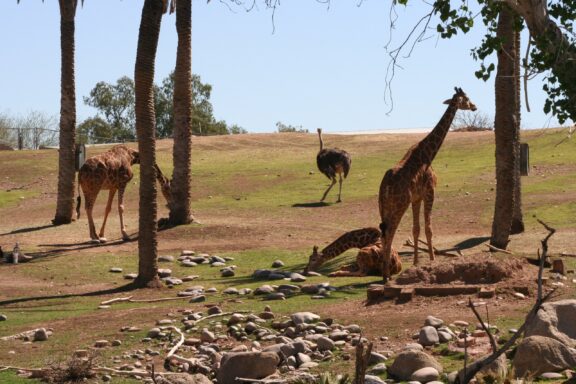
Total Land Area: 125 acres
Official Website: Phoenix Zoo
Recommended Hotel: Quaint Asheboro
As well as being the thirteenth-largest zoo in the US, the Phoenix Zoo is the largest privately owned, non-profit zoo in the country. It was founded by Robert Maytag and opened in 1962, shortly after his death. Since its opening fifty years ago, it has welcomed more than 43 million visitors.
There are more than 2.5 miles (4.0 km) of walking trails at the Phoenix Zoo that enable guests to navigate the more than 1,400 animals on display. There are four main areas in the zoo, each with a distinct theme: the Arizona Trail, which showcases plants and animals from the Southwestern United States; the Africa Trail, which houses animals from Africa; the Tropics Trail, which includes animals that are native to rain forests; and the Children’s Trail, where a petting zoo is located.
The zoo has been involved with conservation and helped to reintroduce the Arabian oryx, an animal that became extinct in the wild in the 1970s, to its natural habitat. It currently utilizes a sanctuary for endangered animals and is involved with boosting populations of native Arizona wildlife.
Ticket prices for 2023 are $37.95 for adults and $27.95 for children up to 13 years of age. Purchasing tickets online is encouraged.
12. Detroit Zoo
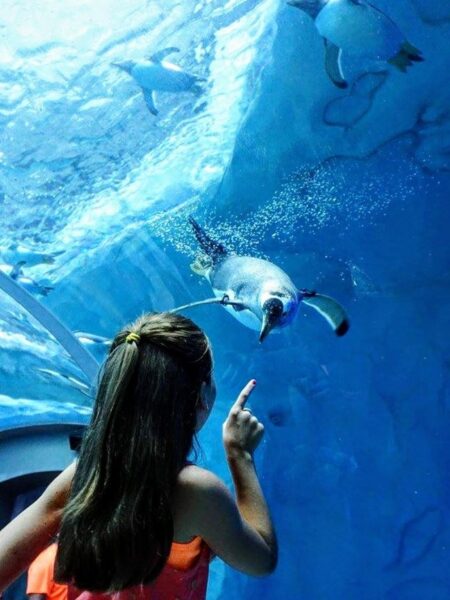
Total Land Area: 125 acres
Official Website: Detroit Zoo
The current Detroit Zoo was opened in 1928 in the state of Michigan and hosted over 1.5 million visitors in its first four months. It was the first zoo in the US to utilize habitats without bars, and animal welfare and conservation are pillars of the zoo’s ideology. It is the largest paid family attraction in the state of Michigan.
Home to more than 2,000 animals of around 233 species, the Detroit Zoo is composed of a number of exhibits. Some of the major exhibits include the Polk Penguin Conservation Center, Arctic Ring of Life, Australian Outback Adventure, Great Apes of Harambe, and more. The Polk Penguin Conservation Center is notable for being the largest center for penguins in the world.
One of the unique experiences available at the Detroit Zoo is the Giraffe Encounter, which allows guests to feed giraffes from a platform that extends into the habitat.
Admission prices for the Detroit Zoo vary and are available for $14-19 for adults and $10-15 for children of 2–18 years with advance purchase online. Tickets are also sold at the gate each day, but numbers are limited.
11. Los Angeles Zoo
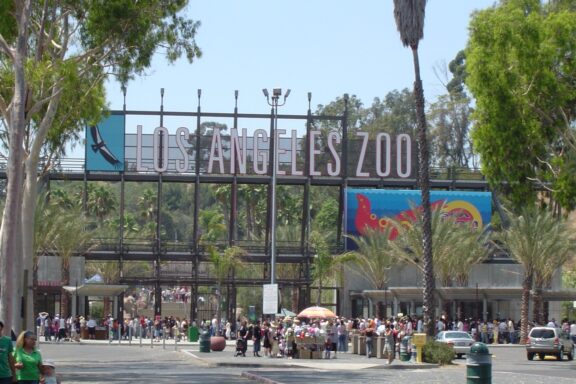
Total Land Area: 133 acres
Official Website: Los Angeles Zoo
The Los Angeles Zoo, located in southern California, is one of the biggest zoos in the US. It spans an area of 133 acres in the northern part of Los Angeles and was first opened in 1966. It was officially renamed the Los Angeles Zoo and Botanical Garden in 2002 when it became officially accredited as a botanical garden.
Two of the several exhibits at the Los Angeles Zoo are the Red Ape Rainforest and the LAIR. The Red Ape Rainforest is a large mesh enclosure that is a recreation of a Southeast Asian jungle and is home to Bornean orangutans. LAIR is an acronym that stands for Living Amphibians, Invertebrates, and Reptiles. The LAIR exhibit features animals like poison dart frogs, Chinese giant salamanders, and a variety of snakes.
One of the successful conservation projects at the Los Angeles Zoo was its Condor breeding program. The bird had become extinct in the wild by 1987, but it has since been reintroduced to parts of northern Arizona, southern Utah, the coastal mountains in California, and Mexico’s Baha California.
It’s best to purchase an advance ticket for admission online, and prices are $22 for adults, $19 for seniors, and $17 for children.
10. Henry Doorly Zoo
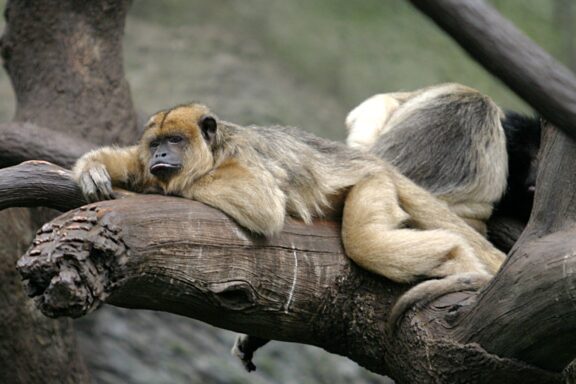
Total Land Area: 160 acres
Official Website: Henry Dooly Zoo
The Henry Dooly Zoo in Omaha, Nebraska is the largest in the state and the tenth-largest in the US. The zoo was opened in 1894 and gets an average of about two million visitors each year. Originally named Riverview Park Zoo, the name was changed in 1963 when Margaret Doorly donated $750,000 and requested that it be renamed in honor of her late husband.
One of the notable features of the Henry Dooly Zoo is that it houses the world’s largest nocturnal exhibit and indoor swamp, named “Kingdoms of the Night.” Some of the many animals in this exhibit include the alligator snapping turtle, naked mole rat, aardvark, Hoffmann’s two-toed sloth, and blind cavefish.
Another special exhibit in this zoo is the Lied Jungle, which is one of the world’s largest indoor rainforest exhibits. Two trails lead through the exhibit, one on the ground level and one that is elevated. Roughly 90 different species can be found in this exhibit, including many monkeys and birds.
Admission prices to the zoo vary throughout the year, ranging from $18.95 in winter to $29.95 for adults. Tickets for children range from $12.95 to $22.95.
9. National Zoological Park
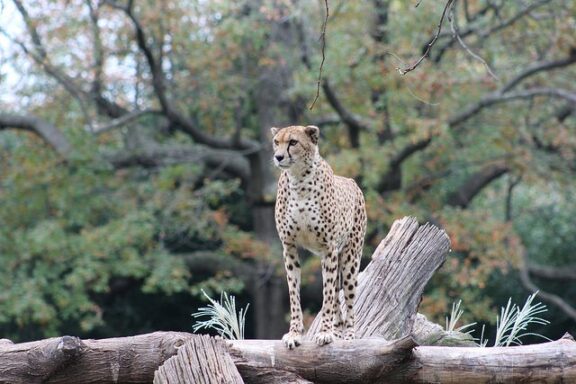
Total Land Area: 163 acres
Official Website: National Zoological Park
The National Zoological Park was founded in 1889 in Washington D.C. and is one of the oldest zoos in the United States. It’s part of the Smithsonian Institution and is often referred to as the National Zoo. When considering that the Smithsonian Institution is the largest museum and research complex in the world, it’s no surprise that the National Zoo is among the largest in the nation.
Receiving nearly two million visitors each year, the National Zoo consists of its campus in Rock Creek Park in Washington D.C., and the Smithsonian Conservation Biology Institute in Virginia is considered an extension of the zoo. Only the 163 acres of the zoo’s Rock Creek campus have been considered for this list.
The National Zoo houses approximately 2,000 animals of hundreds of different species, and admission is free of charge. It is necessary to reserve a free ticket in advance for non-members, and members can walk up to the gate and enter without a ticket.
Of the many animals and exhibits at the National Zoo, the most popular is likely the David M. Rubenstein Giant Panda Habitat and its giant panda inhabitants.
8. Riverbanks Zoo and Garden
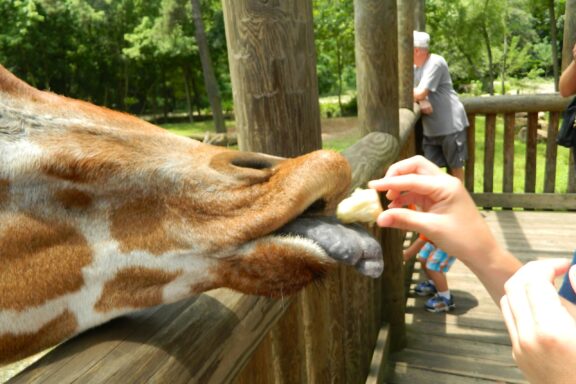
Total Land Area: 170 acres
Official Website: Riverbanks Zoo and Garden
The Riverbanks Zoo and Garden is located in Columbus, the capital city of South Carolina. It is the largest gated attraction in the state and attracts over a million visitors each year. The zoo was opened in 1974 after several years of planning, and the botanical garden was opened to the public in 1995.
An impressive collection of over 2,000 animals live on-site at Riverbanks Zoo, including mammals, reptiles, birds, and fish. One of the zoo’s facilities, the Birdhouse at Riverbanks, was given a Significant Achievement Award by the Association of Zoos and Aquariums (AZA). The Birdhouse features a variety of habitats in exhibits such as Penguin Coast, Asian Trek, and the African and South American Savannas.
In addition to the many types of birds living at the Riverbanks Zoo, there are quite a few other notable animals. Some of these are the Southern white rhino, African elephants, Komodo dragons, lemurs, kangaroos, and many more. The botanical garden boasts more than 4,300 species of plants and hosts workshops as well as functions as an event space.
The general admission rate for adults aged 13 and older is $21.99, and the rate for children is $18.99.
7. Brookfield Zoo
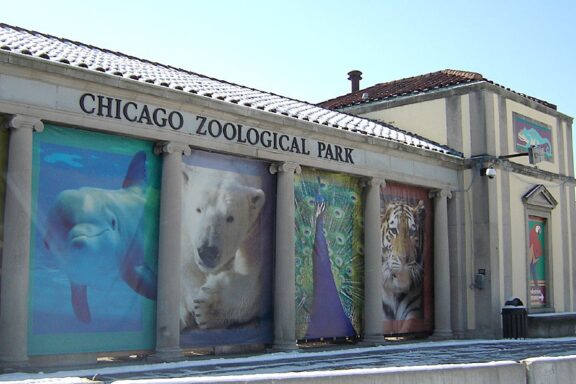
Total Land Area: 216 acres
Official Website: Brookfield Zoo
The Brookfield Zoo, also called the Chicago Zoological Park, is located in Illinois and was opened in 1934. Since its inception, it has utilized moats and ditches instead of cages to separate animals from visitors, which earned the zoo international recognition early on. With an area of 216 acres, this is the fourth-largest zoo in the US.
This zoo is home to more than 2,000 animals of approximately 450 different species and welcomes more than two million visitors each year. There are many different exhibits in the zoo, each featuring animals from a different geographical region. The Australia House is home to animals like wallabies, pythons, and emus. The animals living in Desert’s Edge include foxes, lizards, and meerkats. Hundreds of other animal species both big and small populate the other exhibits in the zoo.
The Brookfield Zoo has gained recognition for a variety of feats. It was the first zoo in the United States to host giant pandas and the first in the country with a fully indoor dolphin exhibit. The zoo was also the first in the world with a fully indoor rainforest simulation.
The admission price is $17.95 for children and $24.95 for adults.
6. Bronx Zoo
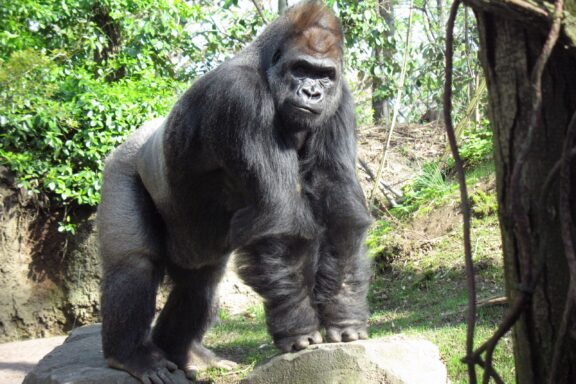
Total Land Area: 265 acres
Official Website: Bronx Zoo
The Bronx Zoo is the largest metropolitan zoo in the United States and among the largest in the country overall. It’s located in Bronx Park in New York and covers 265 acres of land. The zoo was opened in 1899 and has been focused on animal conservation efforts since its founding. Since 2009, the Bronx Zoo has welcomed an average of just over two million visitors each year.
There are more than 4,000 animals from over 650 different species that live at the Brox Zoo, many of which are endangered or threatened. The zoo played a role in helping to reintroduce the American Bison to the wild as well as reintroducing the Chinese alligator to the Yangtze River in China.
Admission prices vary by season, and reduced admission tickets are available for Wednesdays. All tickets must be reserved in advance. Winter admission for adults over the age of 13 is $33.95, seniors over the age of 65 pay $28.95, and children 12 and younger are $23.95.
5. Binder Park Zoo
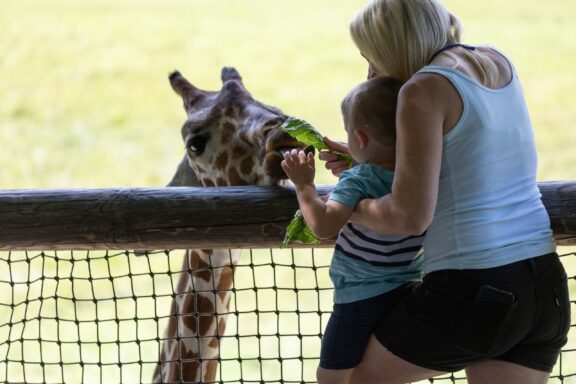
Total land area: 433 acres
Official website: Binder Park Zoo
Located near Battle Creek, Michigan, Binder Park Zoo is one of the largest zoos in the United States, covering a sprawling 433 acres. It opened its doors in 1977 and has since become a significant attraction in Michigan for its extensive variety of animals and plants.
The zoo’s considerable size has allowed for the creation of expansive and immersive exhibits, such as the renowned Wild Africa Exhibit. This exhibit transports visitors to an African savanna where they can observe giraffes, zebras, lions, and more in their natural habitat.
Another notable feature is the zoo’s conservation efforts, which are evident throughout the park, emphasizing the importance of protecting wildlife and natural environments.
Aside from animal exhibits, Binder Park Zoo also offers interactive experiences, such as feeding the giraffes, which is a favorite among visitors of all ages. Educational programs and events are held regularly, providing insights into wildlife and conservation topics.
Admission to the zoo is ticket-based, with different pricing for various age groups. Prices for adults in 2024 are $17.25, and discounts are available for seniors and children.
4. Minnesota Zoo
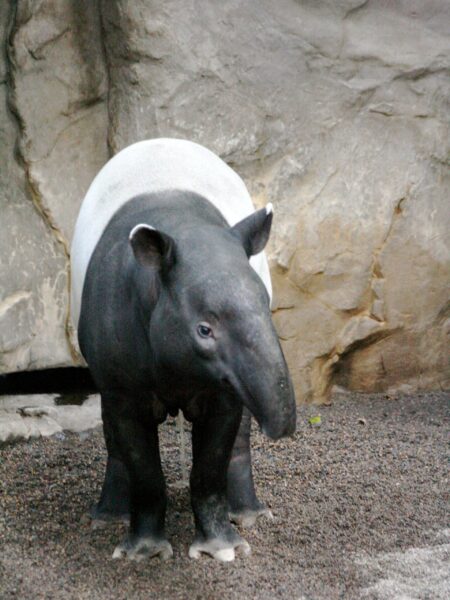
Total Land Area: 485 acres
Official Website: Minnesota Zoo
The Minnesota Zoo is the fourth-largest zoo in the US. With a total area of 485 acres, it is more than 200 acres larger than the next-largest zoo in the country. It is located in Apple Valley, Minnesota and was opened in 1978. This zoo was one of the first to organize its animals according to their habitats instead of by species, which was possible in part because the zoo had such a large area to work with.
There are six themed areas in the Minnesota Zoo that each house exhibits of animals from different habitats around the globe. The Medtronic Minnesota Trail leads through more than fifteen exhibits with animals that are native to the area like the American black bear, bald eagle, and coyote. Russia’s Grizzly Coast is an area in the zoo that simulates the Russian Far East and houses animals like brown bears, Amur leopards, and wild boars.
In addition to the animal exhibits, the zoo includes an outdoor amphitheater and a conservation carousel. The amphitheater is used for bird shows during zoo hours in the summer and hosts live music after zoo hours.
Online purchase of tickets is required for admission. Prices are $13.95 for children from the ages of 3-12, $19.95 for adults, and $13.95 for seniors over 65 years old.
3. Columbus Zoo and Aquarium
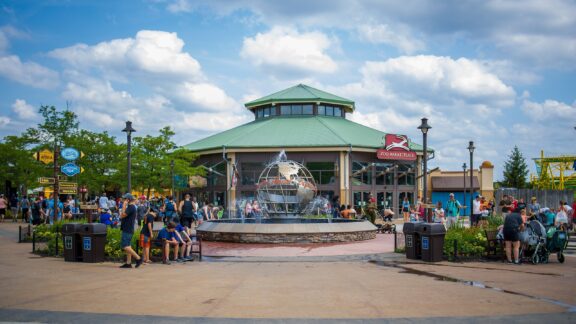
Total Land Area: 580 acres
Official Website: Columbus Zoo and Aquarium
The Columbus Zoo and Aquarium is in the top three largest zoos in the US. It owns a total of 580 acres of land that houses more than 7,000 animals of more than 800 different species and receives more than 2.3 million visitors each year. Some of its accolades include being named the number one zoo in the US by USA Travel Guide in 2009 and ranking as the number one best zoo by Besties Readers Choice in 2012.
Animals at the Columbus Zoo are organized into eight different regions, each themed for the area of the world it represents. The North American region of the zoo is the largest and includes 15 large animal exhibits. Some of the animals here are the American black bear, the Mexican wolf, and the North American river otter. The Polar Frontier region houses polar bears and the Arctic fox, among others, and the Heart of Africa is home to camels, lions, giraffes, and many more African animals.
In addition to onsite activities, the Columbus Zoo runs a conservation program that is involved with projects outside of the zoo by funding grants that support conservation projects. It is also involved in internal conservation projects.
Admission is $24.99 for adults and $18.99 for seniors and children under 10 years old.
2. San Diego Zoo Safari Park
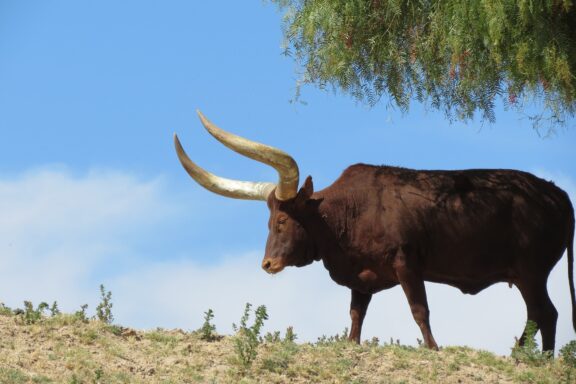
Total Land Area: 1,800 acres
Official Website: San Diego Zoo Safari Park
The second-largest zoo in the US is the San Diego Zoo Safari Park. Together with the San Diego Zoo, it is part of the San Diego Zoo Wildlife Alliance and was originally planned to be a supplemental breeding facility to the existing zoo. Eventually, it was decided to make the land a natural environment zoo, and it was opened in 1972.
There are about 3,000 animals representing 400 different species in this giant zoo, and about two million people visit each year. The largest exhibits in the zoo are the Asian Savanna and African Plains. These open-range enclosures cover more than 300 acres and are home to one of the largest collections of hoofed animals in the world.
Two of the park’s major exhibits are the African Woods and African Outpost. The exhibits are connected by a trail for visitors and replicate different habitats in Africa. Animals here include vultures, the giant eland, bat-eared foxes, and colobus monkeys, among others.
Multiple ticket options are available, but a day pass is around $70 for an adult and $60 for a child.
1. North Carolina Zoo
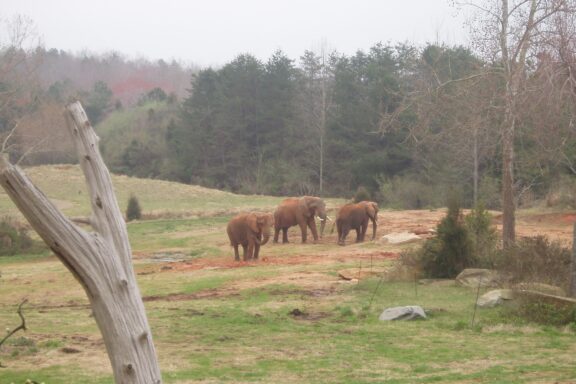
Total Land Area: 2,600 acres
Official Website: North Carolina Zoo
The largest zoo in the US, and the largest natural habitat zoo in the world, is the North Carolina Zoo. The grounds of this zoo cover an incredible 2,600 acres, though it’s worth noting that around 500 acres of this land have been developed.
North Carolina Zoo is located in the central part of the state, 25 miles (40 kilometers) south of the city of Greensboro. Along with the Minnesota Zoo, it is one of only two state-funded zoos in the United States.
There are more than 1,800 animals living at the North Carolina Zoo, and visitors can take advantage of amenities like hiking trails, the butterfly garden, and the giraffe deck. The main regions represented in the zoo’s habitats are North America, Africa, and the global desert. There is also an aviary that recreates the conditions of a tropical forest.
In addition to its considerable size, some notable features of the North Carolina Zoo are that it houses one of the largest numbers of chimpanzees and the largest collection of Alaskan seabirds in the country. It is also home to one of the only breeding pairs of polar bears in the US.
Tickets are available at the gate and online, ranging from $11 for children to $15 for adults. North Carolina Zoo members enter free of charge.
Image Sources and Copyright Information
- Giraffes and an Ostrich Roaming in a Zoo Savanna Exhibit: © Dave Pape/Wikimedia Commons | Public Domain Mark 1.0
- Visitor Interacting with Penguins at an Aquarium Exhibit: © Detroitzoo/Wikimedia Commons | CC BY-SA 4.0 International
- Entrance of the Los Angeles Zoo with Visitors on a Sunny Day: © Geographer/Wikimedia Commons | CC0 1.0 Universal
- Contemplative Black Howler Monkey Resting on a Tree Branch: © Cburnett/Wikimedia Commons | CC BY-SA 3.0 Unported
- Cheetah on Watchful Perch at Conservation Station: © Ahbeall | CC BY-SA 4.0 International
- Close-up Interaction with a Giraffe at a Zoo: © Surfer43/Wikimedia Commons | CC BY-SA 3.0 Unported
- Entrance of the Chicago Zoological Park with Animal Banners: © Derek Taylor/Wikimedia Commons | CC BY-SA 2.5 Generic
- Majestic Gorilla Standing on a Rock at the Zoo: © Anagoria/Wikimedia Commons | CC BY 3.0 Unported
- Mother and Child Feeding a Giraffe at the Zoo: © Jim_Brown_Photography/Shutterstock
- Malayan Tapir Standing in a Zoo Enclosure: © Jim Windstead/Wikimedia Commons | CC BY 2.0 Generic
- Busy Day at the Zoo Entrance with Visitors and Fountain: © loganrickert/flickr | CC BY 2.0 Generic
- Ankole-Watusi Cattle with Large Horns at San Diego Zoo Safari Park: © Raw2daBon3/Pixabay
- Elephants Grazing in a Serene Enclosure at the North Carolina Zoo: © Philthecow/Wikimedia Commons | CC BY-SA 3.0 Unported